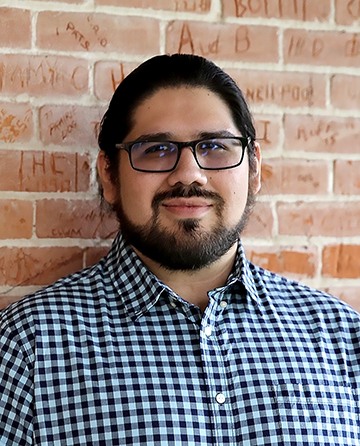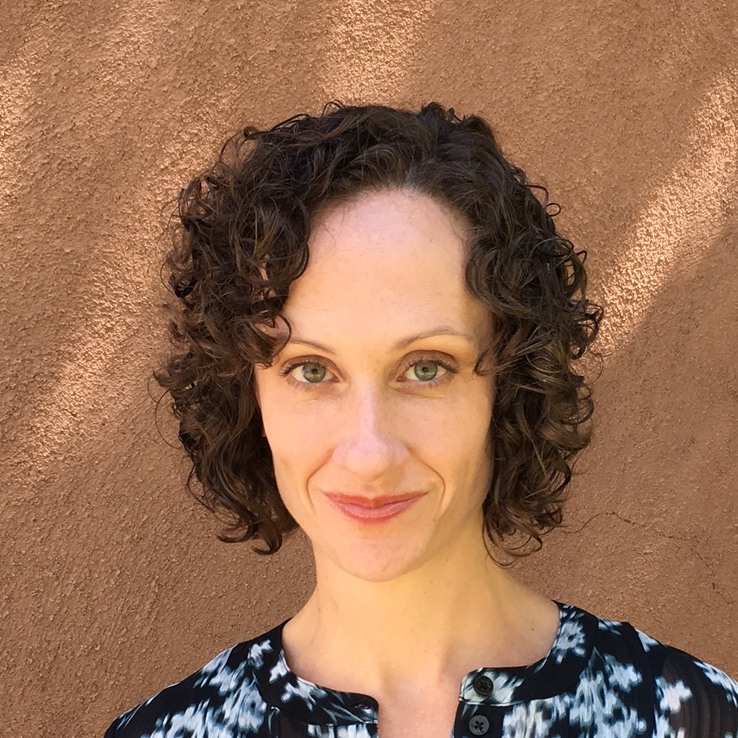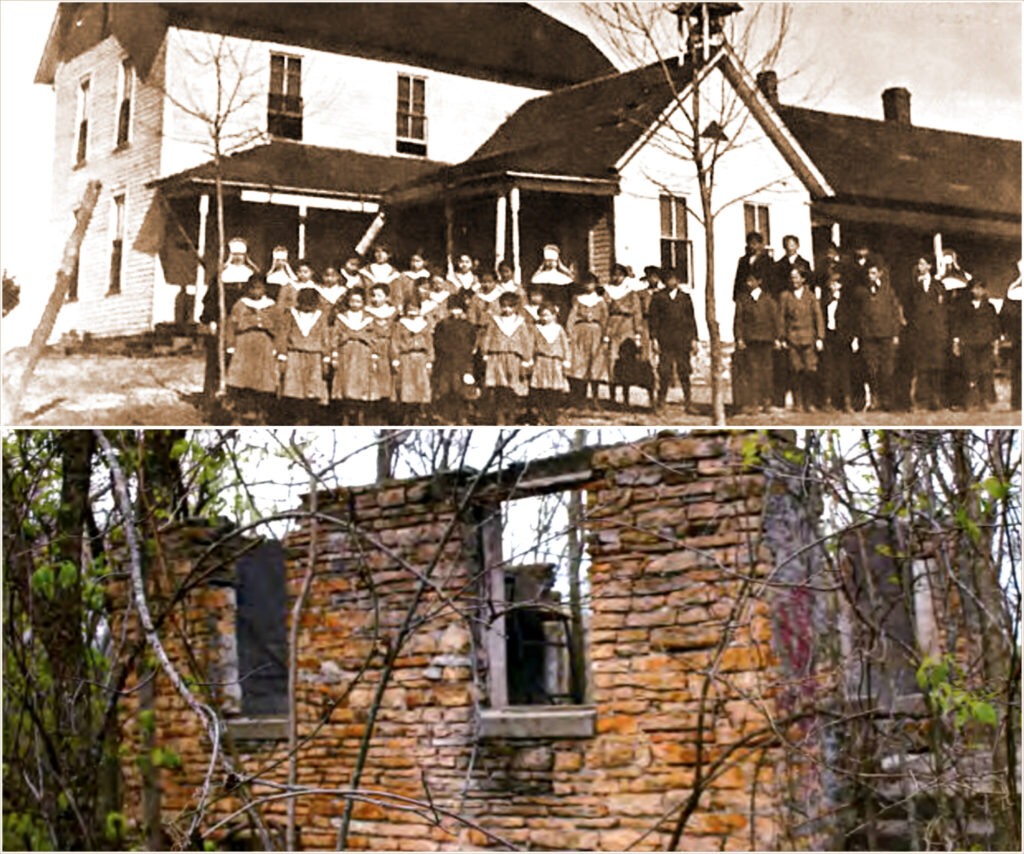New Archive Sheds Light on Indian Boarding Schools Run by the Catholic Church
A long-awaited online archive may help survivors find answers.
Nancy Marie Spears
The Imprint

“The only thing we have left is the cemetery where many of our Quapaws are buried,” says Carrie Wilson, whose mother was forced to attend St. Mary of the Quapaws school in Oklahoma. Photo illustration by Julie Reynolds from archival image.
This article is being co-published with The Imprint, a national nonprofit news outlet covering child welfare and youth justice.
Carrie V. Wilson grew up with stories of her mother as a small child attending St. Mary’s of the Quapaw boarding school in Lincolnville, Oklahoma.
As chair of the cultural committee for Quapaw Nation, Wilson is well-versed in the importance of passing down accurate legacies for future generations. Wilson, now 68, recalls roaming the remnants of the old boarding school and its graveyard on her reservation when she was a child.
There were only a few memories that her mother, Edna, told her about the Catholic boarding school experience: that it was a scary place for a little girl. Being away from her family, the nuns in their habits — it was a strange, unusual environment, and she spent much time crying. Unable to assimilate, Edna’s mother came and took her home. Eventually, Edna and her brothers were sent to Seneca Indian School.

Now, 17 years after her mother’s death, some answers that have long remained elusive may emerge. St. Mary’s shut down in 1927 with few accessible records left behind, but it now appears on a first-of-its-kind list of Catholic-run boarding schools for Native children.
The recently published online database provides vital breadcrumbs of information for survivors and their descendants, including the tribal members of Quapaw and countless others across the nation.
The list of Native boarding schools overseen or staffed by the Catholic Church prior to 1978 was made public last month by a group of archivists, historians and “concerned Catholics.” The Catholic Truth and Healing list is described by its authors as “the first and most comprehensive source” of such information.
Information from the database about St. Mary’s includes its dates of operation, beginning in 1894; affiliated dioceses, such as the Vicariate Apostolic of Indian Territory; the career paths of the Sisters of St. Joseph, who taught there; and which religious order worked at the school: the Congregation of Divine Providence.
Wilson said information such as this is desperately needed, as the elders who know the most about the school like the one her mother attended — and those most in need of reconciliation and healing from a harmful past — aren’t getting any younger.
“Most of those people who participated and knew the history of the boarding school first hand are gone,” Wilson said of St. Mary’s. “The only thing we have left is the cemetery where many of our Quapaws are buried.”
The church’s role
The Catholic Church was a key player in the devastating colonization of the Americas, operating more Indian boarding schools in the United States than any other religious group, and more than all other religious groups combined, according to Kathleen Holscher, an associate professor and endowed chair of Roman Catholic Studies at the
University of New Mexico. These numbers, she said, come from lists created by the Catholic Truth and Healing initiative and the National Native American Boarding School Healing Coalition.
Indian boarding schools operated in the United States between 1819 and 1977, and were part of centuries-long attempts by the U.S. government and Christian missionaries to eradicate Native culture and traditions by removing children from their parents and tribes.
At the heart of the project documenting the role of the Catholic Church are the families of survivors and their descendants, who “deserve prioritized access to information regarding their own histories,” the archivists’ state.
“I’VE SEEN ELDERS WHO HAVE ALREADY FOUND HEALING IN THEIR OWN LIVES AND ARE DEEPLY AWARE OF HOW IT IMPACTED THEM IN GOOD AND BAD WAYS. THERE ARE OTHERS WHO ARE STILL IN A VERY DARK PLACE.”
MAKA BLACK ELK, EXECUTIVE DIRECTOR OF TRUTH AND HEALING, RED CLOUD INDIAN SCHOOL
The database expands on publicly available information compiled by the U.S. Department of the Interior and the National Native American Boarding School Healing Coalition. The Interior Department’s 2022 findings — launched by Deb Haaland, an enrolled citizen of the Laguna Pueblo tribe and the country’s first Indigenous cabinet secretary — named individual schools.
The new archive, searchable by state, focuses only on Catholic-run institutions. It lists 87 schools operated by 79 religious orders across 22 states. Each entry chronicles details like school names, which often change over time; locations, including whether the school is or was on a reservation; the current and previous religious orders that operated each school; and the local tribal nations likely impacted. Religious orders and dioceses that were involved in the operation of each boarding school are also listed.
Indigenous advocates and descendants of boarding school survivors say the information is long overdue and provides a solid first step in what can be an arduous process of learning about the past and attempting to heal. But the accounting may not provide all the answers or the comfort sought, said Maka Black Elk, an Oglala Lakota member who contributed to the database.

“People need different things to heal,” said Black Elk, the executive director of truth and healing at Red Cloud Indian School in Pine Ridge, South Dakota. “I’ve seen elders who have already found healing in their own lives and are deeply aware of how it impacted them in good and bad ways. There are others who are still in a very dark place.”
Jerilyn DeCoteau, a member of the Turtle Mountain Band of Chippewa in North Dakota and a tribal law attorney, also worked on the project. DeCoteau said her advocacy for accurate teachings about boarding schools stem from her family’s experience.
DeCoteau’s parents went to schools run by the Bureau of Indian Education — under the Interior Department — where they were barred from speaking Cree and Michif, a dialect of Canadian French combined with Cree.
Later, her siblings attended the Catholic-run St. Ann’s Mission day school on the reservation. Day schools were often similarly abusive, fueling “another set of horrible stories” and a second generation robbed of their native languages, she said. “As siblings, we just always felt so, so cheated.”
DeCoteau described the punishing boarding school legacy as extending beyond language loss.
“Even though my parents were not bad people and always did their best, they grew up very regimented, away from their families in boarding schools,” she said. “They didn’t learn a lot of parenting skills.”
‘A source of intergenerational trauma’
The movement to document Indian boarding schools in the U.S. and the harm they’ve caused over generations is growing — similar to a reckoning underway in Canada.
In the U.S., the National Native American Boarding School Healing Coalition produced its accounting in 2020, listing 367 schools across the country, followed in 2022 by the Interior Department’s report identifying 408 schools across 37 states or then-territories. Amid the horrors reported were over 500 child deaths in 19 schools. The government also uncovered 53 marked and unmarked burial sites on these schools’ grounds.
About half the schools were supported by the U.S. government, but were operated and staffed by Christian denominations, including the Catholic Church. Federal archives show the U.S. government “coerced, induced, or compelled Indian children to enter” the schools, with treatment including, but not limited to “solitary confinement; flogging; withholding food; whipping; slapping; and cuffing.”
The Catholic Truth and Healing list has still more confirmation of the abuse. Its website notes that “the boarding school policy has been recognized by Tribal Nations, scholars, and many others, including Pope Francis, as one of cultural genocide and a source of intergenerational trauma with continuing effects today.”

Yet uncovering that troubled past remains difficult. Professor Holscher, who has reviewed the new database, said the complex structure of the Catholic Church makes it difficult for boarding school survivors and their families to research their history.
The scope of the church and its many dioceses and religious orders is among the challenges. Each diocese was run by bishops operating independently from each other. In addition, male and female religious communities operated boarding schools within the geographic boundaries of dioceses but answered to their own, separate leadership.
“The Catholic stuff is complicated,” Holscher said, even for someone who studies the church. “Why should the survivors be expected to know any of that?”
The new archive does not require the Catholic Church to give tribes or descendants access to physical records. It also does not include church archives that may detail attendance records, the names, ages and number of students who attended, or any reports of mistreatment, neglect or wrongful deaths.
A brutal legacy
The federal policies that created Indian boarding schools began with the Indian Civilization Fund Act of 1819, passed by Congress, and the Peace Policy of 1869, signed by former President Ulysses. S. Grant: Churches and boarding schools were called on to “stimulate the ‘civilization process,’” and Christian missionaries were authorized to oversee education on tribal lands. By the 1880s, the Catholic Church was receiving the most federal appropriations of any religious group, Holscher said.
According to the National Native American Boarding School Healing Coalition, U.S. government policies resulted in nearly 83% of American Indian and Alaska Native school-age children attending the schools by 1926.
For this article, The Imprint interviewed people directly involved with the creation of the Catholic boarding school archive, as well as others descended from students who survived schools listed in the database or are advocates for truth and healing within their tribes.
Their views about this legacy reveal a range of experiences, from painful memories to a fondness for certain church groups working with tribes to preserve their language. Those who’ve remained in the Catholic faith described conflicting emotions at times.
Many tribal members suffered brutality at the schools where physical abuse, deprivation of basic necessities and sexual violence were rife, even when tribes had cooperated with their formation.
The Quapaw originally sent their children to schools off the reservation, but their names were changed or they came home not speaking their language, Wilson said. Many who returned “no longer fit into their Indian world or that white world.”
The Quapaw Tribe gave the Catholic Church 40 acres of land to build and operate St. Mary’s to keep tribal children from being taken off the reservation, she said.
“They absolutely believed education was important to survive in that white man’s world. But they didn’t want to lose their children.”

The schools have a well-documented legacy of suppressing Native languages: forcing students to speak and write only in English, and severely punishing children who defied orders. But Black Elk of the Pine Ridge Reservation — who graduated from Red Cloud in 2005, following his grandfather’s path — described nuances therein. Today the school is operated by his tribe as a Lakota-Catholic day school, named after an Oglala Lakota leader.
Before the school opened, he said, there was a strong relationship between the Lakota people and the Society of Jesus. The Catholic religious order for men had been in close contact with the Lakotas, learning their language and translating the Bible into Dakota and Lakota languages. Red Cloud, the tribe’s chief, traveled to Washington, D.C., in the early 1880s to request a special allowance for the Jesuits to create a boarding school on the reservation.
The Jesuits who initially staffed the school emigrated from Germany, and for the first decade of its operation, Lakota students and German-speaking priests learned English together, a tribal member who attended the boarding school in the 1950s told Black Elk in interviews for the research project. At that time, it was known as the Holy Rosary Mission School.
Asked about this community elder’s retention of her native language, Black Elk said, “She feels strongly that the boarding school never really beat it out of her, that she never lost it.”
“One of the Jesuits spoke fluent Lakota also, and he would talk with her regularly,” he added. “That was a big part of her life’s formation.”
“GIVEN THE LENGTH OF TIME THESE SCHOOLS WERE IN OPERATION, IT WILL LIKELY TAKE MULTIPLE GENERATIONS TO ADDRESS THE HARM CAUSED.”
JAIME ARSENAULT, TRIBAL HISTORIC PRESERVATION OFFICER FOR WHITE EARTH NATION
Black Elk said history is complex and culturally specific to each tribe, and Indigenous people who follow the Catholic faith can experience additional layers of complexity. As a Lakota Catholic, he believes he can hold his church accountable, making the Church and his own faith stronger in the process.
“Those things aren’t always in conflict as much as we’d like to think they are,” Black Elk said.
Jaime Arsenault is the Tribal Historic Preservation Officer for White Earth Nation in Minnesota. She learned about the legacy of boarding schools at a young age, which propelled her to find ways to address the intergenerational harm as communities work towards healing.
“Within the United States, the boarding schools lasted about seven generations,” Arsenault said, “and during this time, Indigenous communities and generations of families experienced significant harm and complex trauma that is still felt today. Given the length of time these schools were in operation, it will likely take multiple generations to address the harm caused.”
Arsenault described the new Catholic school archives as part of this generation’s obligation to the next — so the weight they carry in this work will be a little lighter, and fewer families will have to experience the same pain of not knowing what their relatives endured.
She agrees with Black Elk that it can be sensitive navigating Indigenous Catholicism within Indigenous communities. But she added that the unique and diverse experiences of survivors are vital to preserve.
“As manager of the White Earth Tribal Archives, I’m actively gathering and accepting interviews of community member accounts of boarding school experiences,” Arsenault said. “There’s been a real range of experiences, and all are important and worth remembering.”
External
The tree features names of missing Indigenous people
The billboard project is expanding to Oregon
Identification not yet made
UTTC International Powwow attendees share their rules for a fun and considerate event
Radio collaboration highlights importance of cooperation in a season of funding cuts for local media






